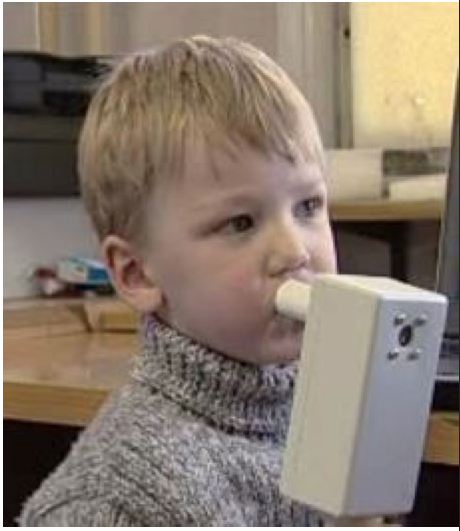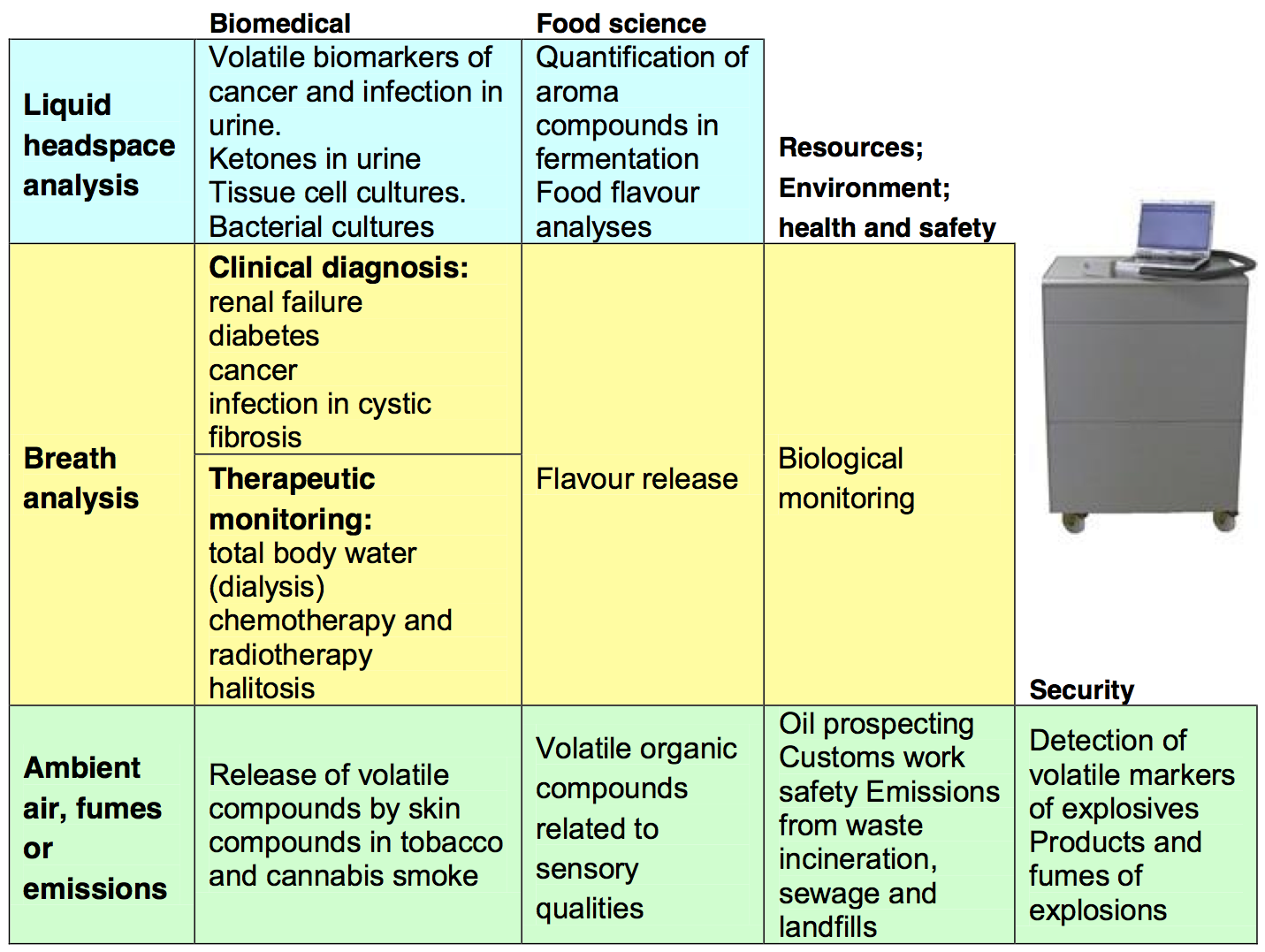SIFT-MS: instruments for breath analysis and trace gas analysis in medicine and industry
Submitting Institution
Keele UniversityUnit of Assessment
General EngineeringSummary Impact Type
TechnologicalResearch Subject Area(s)
Physical Sciences: Other Physical Sciences
Chemical Sciences: Analytical Chemistry, Physical Chemistry (incl. Structural)
Summary of the impact
A novel technique named Selected Ion Flow Tube-Mass Spectrometry,
SIFT-MS, has been researched and developed by Professor David Smith and
Professor Patrik Spanel at the Institute for Science and Technology in
Medicine (ISTM), Keele University. This technique allows real time,
on-line analysis of trace gases in air and exhaled breath. This
development stems from basic research into the reactivity of ions in the
gas phase, in which Smith & Spanel are recognised international
experts, combined with a complete understanding of the engineering and
technical requirements of successful analytical instrumentation. SIFT-MS
instruments have been developed initially from large laboratory devices to
the current, transportable commercial instruments that are produced by two
independent manufacturers and sold worldwide. They are used in various
fields of research, including immediate analysis of exhaled breath and
urine headspace for clinical diagnosis and therapeutic monitoring, cell
biology, and in environmental and food sciences. They have important
practical use in the safety of customs workers in container ports and in
prospecting for oil and gas. SIFT-MS instruments manufactured in the UK
have been exported to Austria, Czech Republic, China and the USA.
Underpinning research
The SIFT-MS technique for trace gas analysis was developed under the
leadership of Professor David Smith FRS (DS, currently Professor of
Chemical Physics and a Head of the Trace Gas Analysis Group), who also
pioneered the selected ion flow tube, SIFT, technique for the study of
ion-molecule kinetics that continues to be used in laboratories around the
world to elucidate the ion chemistry of terrestrial and other planetary
atmospheres and interstellar clouds (see Smith & Spanel 1995). DS is
still considered as a world leader in astrochemistry and his extensive
published works (>400) continue to attract great numbers of citations
(>13000). It is his understanding of ion chemistry in the gas phase
that underpins accurate SIFT-MS analyses of trace gases. In SIFT-MS,
selected reagent ions react with molecules of an air/breath sample
introduced into the flow tube and the resulting product ions are
quantified by mass spectrometry. Using the known reaction rate
coefficients, the concentrations of several trace gases present in the
sample (e.g. breath exhalations) can be immediately calculated. The rate
coefficients and the product ions for hundreds of reactions of H O+,
+NO and O +2 reagent ions with a wide range of
(largely) organic compounds have been determined at Keele University since
1996 (see Smith & Spanel 2005). These results have been reported in
many peer- reviewed research and review publications and similar studies
are ongoing for many more compounds as SIFT-MS is more widely applied to
the analysis of new analytes detected in exhaled breath and evolving from
cell cultures and foods.
The SIFT-MS analytical method was first conceived during the
collaboration between DS and Professor Patrik Spanel (PS, Professor of
Chemical Physics) in 1995 when they commenced their research at Keele,
specifically to develop SIFT-MS, focusing on breath analysis for clinical
diagnosis and therapeutic monitoring with initial probing experiments
relating to health and safety and food science. The first
proof-of-principle experiments were carried out on a large SIFT instrument
(2000 kg). Development of numerical algorithms and software for automated
quantification also began. Years of intensive research (1995 to 2006) in
the areas of flow dynamics, gas sampling methodologies directed towards a
wide range of applications (for example, analysis of breath from children
and frail patients), and the formation of an extensive library of
ion-molecule kinetics, combined with development of instrument rigs and
software, resulted in the smallest and most versatile SIFT-MS instrument,
Profile 3 (120 kg), that is transportable and can be located
at the point-of-care in the clinical environment. Using such instruments,
quantification of trace amounts of volatile organic compounds (down to the
parts-per-billion by volume, ppbv) is achieved. Interdisciplinary
studies have been carried out at ISTM, Keele, and the North Staffordshire
Hospital Trust (now UHNS) during the period from 1997 to the present,
involving the following specialists: Professors Simon Davies
(nephrologist), Professor James Elder (GI surgeon), Professor Warren
Lenney (respiratory paediatrician), Professor Alicia El Haj (cell
biologist), Dr. Josep Sule-Suso (oncologist), together with external
collaborators who have also adopted SIFT-MS.
Notable research results that demonstrate the impact of SIFT-MS are:
- reference ranges for several breath metabolites in the healthy
population
- quantification of breath ammonia in renal failure and during
haemodialysis
- volatile biomarkers in urine from patients with prostate and bladder
cancer
- characterisation of volatiles from in vitro cell and bacterial
cultures
- HCN in the breath of cystic fibrosis patients as a marker of Pseudomonas
infection
- measurement of total body water in haemodialysis- and peritoneal
dialysis patients Breath analysis is now a recognised new and attractive
tool in medicine (diagnosis and therapy) and physiology (transport of
metabolites from cells to exhaled breath from nose and mouth,
pharmacokinetics), not least because it is totally non-invasive. SIFT-MS
researchers at Keele are amongst the pioneers and leaders in this field.
The SIFT-MS quantitative approach to breath analysis has changed the
paradigm in this field from the search for qualitative patterns to the
discovery of objectively measurable biomarkers.

References to the research
(Three key references are underlined.)
P. Španěl, D. Smith. Progress in SIFT-MS: breath analysis and other
applications Mass Spectrom. Rev. 2011 30(2):236-267. doi:10.1002/mas.20303
(cited 40 times)
D. Smith, P. Španěl. Ambient analysis of trace compounds in gaseous media
by SIFT-MS Analyst 2011 136:2009-2032. doi:10.1039/c1an15082k
(cited 12 times)
D. Smith, P. Španěl. Selected ion flow tube mass spectrometry
(SIFT-MS) for on-line trace gas analysis. Mass Spectrom. Rev.
2005 24(5):661-700. doi:
10.1002/mas.20033 (cited 210 times)
D. Smith, T.S. Wang, J. Sule-Suso, P. Španěl, A.J. El Haj. Quantification
of acetaldehyde released by lung cancer cells in vitro using
selected ion flow tube mass spectrometry Rapid Comm. Mass Spectrom.
2003 17(8):845-850 (cited 62 times).
S. Davies, P. Španěl, D. Smith. Rapid measurement of deuterium content of
breath following oral ingestion to determine body water. Physiol. Meas.
2001 22(4):651-659. (cited 25 times)
P. Španěl, D. Smith. SIFT studies of the reactions of H3O+,
NO+ and O +2 with a series of alcohols Int.
J. Mass Spectrom. Ion Proc. 1997 167-168:375-388. doi:
10.1016/S0168-1176(97)00085-2 (cited 108 times)
S. Davies, P. Španěl, D. Smith. Quantitative analysis of ammonia on
the breath of patients in end-stage renal failure Kidney Int.
1997 52(1):223-228. doi:10.1038/ki.1997.324
(cited 103 times)
D. Smith, P. Španěl. Ions in the Terrestrial Atmosphere and in
Interstellar Clouds. Mass Spectrom. Rev. 1995 14(4-5):255-78
doi:
10.1002/mas.1280140403 (cited 98 times)
| Name |
Title |
Sponsor |
Period |
Value |
| D. Smith |
TSIFT Instrument |
NHS West Midlands LORS (Locally organised research scheme) |
1996-1997 |
£80,000 |
| D. Smith |
Application of SIFT-MS for breath analysis |
EPSRC |
1999-2002 |
£260,000 |
| S. Davies |
FA-MS for total body water |
Wellcome Trust |
2002 |
£65,000 |
| W. Lenney |
Paediatric SIFT-MS in North Staffordshire |
GlaxoSmithKline |
2004 |
£60,000 |
| D. Smith |
SIFT-MS instrument |
SRIF (Science Research Infrastructure Fund) |
2005 |
£135,000 |
Details of the impact
SIFT-MS is now a valuable method for ambient trace gas analysis, and the
transportable instrument, built by a local company (Crewe, UK,
corroborating source 1) according to the design of PS and DS, allows
on-line analysis at the point-of-care obviating sample collection. Thus,
examples of the research carried out are the pilot studies at Keele and
UHNS of the metabolites in the exhaled breath of healthy volunteers and
patients with renal failure; analyses at the health and safely laboratory,
HSL, Buxton, of the exhaust gas from a diesel engine of the kind used in
coal mines; establishment of concentration reference ranges for a number
of common breath metabolites prior to the study of patients with various
diseases at the Silsoe Research Institute, SRI.
Canterbury University, New Zealand, adopted the SIFT-MS method and
replicated these instruments in 2001. Their spin-off company, SYFT
Technologies (source 2), then began to commercialise the SIFT-MS method
implemented in their own design of instruments (Voice 100 (200
kg) and 200 (400 kg)), that draw heavily on the many
published results of the Keele research and development group. More than
50 of these Profile 3 and Voice instruments have been sold
(£70 - 200,000 each) and are in use around the world.
The international dimension of SIFT-MS is seen by its adoption in the UK:
Keele, Open University, Imperial College London. Czech Republic: Academy
of Sciences, Prague. Canada: Lakehead University Ontario. New Zealand:
Canterbury and Otago Universities. U.S.A: Ohio University. Spain: IATA
Valencia). SIFT-MS instruments are also being used to monitor cargo
containers in ports in Australia and Europe (source 3), for oil and gas
prospecting in Australia and New Zealand, and in other important areas
where volatile compound analysis is valuable, as summarised in the Table
below.
Worthy of special mention is the work carried out by Professor Simon
Davies at Keele and UHNS on the measurement of total body water, TBW,
using Flowing Afterglow-Mass Spectrometry, FA-MS (a variant of SIFT-MS).
This is accomplished by measuring the deuterium content of exhaled water
vapour following the ingestion of a known quantity of deuterated water
(Davies et al, 2001). A multi-centre study is now (2012) demonstrating the
benefit to end-stage renal patients of regular and accurate monitoring of
TBW, using FA-MS and SIFT-MS, by assessing added value of measuring body
composition in the clinical management of dialysis patients.

The related analytical method known as PTR-MS is also directly based on
the above-mentioned research into the ion chemistry of H 3O at Keele
(source 4). PTR-MS instruments are more sensitive but lack the absolute
accuracy of SIFT-MS. Recently, NO+ and O +2
were introduced as reagent ions in PTR-MS in an attempt to make this
technique more competitive with SIFT-MS. These instruments are widely used
in atmospheric monitoring, but have had limited application in breath
analysis and food technology.
SIFT-MS has contributed to a paradigm shift in breath analysis. In the
area of healthcare the increasing availability of SIFT-MS instruments has
resulted in joint projects with medical groups, since breath biomarkers
can distinguish healthy and disease states. Evidence for this are the
joint publications with clinical specialists, which have attracted
hundreds of citations. Thus, in 2007, The Journal of Breath Research
(JBR) was introduced, published by IOP Publishing, and DS
and PS were invited to be founder members of the Editorial Board.
Currently, the papers co-authored by PS and DS fill 5 of the top 10 most
cited papers in JBR and attracted some 20% of all citations to JBR papers
(source 5, citations from Web of Science). DS is co-editor of two
published books:
-
Breath analysis for clinical diagnosis and therapeutic monitoring.
World Scientific, 2005.
-
Volatile biomarkers. Non-invasive diagnosis in physiology and
medicine. Elsevier, 2013.
Sources to corroborate the impact
- Chief Executive Officer at Instrument Science, a UK company selling
SIFT-MS instruments
http://www.instrumentscience.com/.
- Chief Technical Officer at Syft Technologies, a New Zealand company
selling SIFT-MS instruments http://www.syft.com/.
- SIFT-MS at seaports http://www.nzine.co.nz/features/syfttoxicityscreening.html
- Chief Technical Officer at Ionimed Analytik GmbH, a European company
selling PTR-MS instruments http://www.ionicon.com/
- Journal of Breath Research http://iopscience.iop.org/1752-7163/
- Material World, BBC Radio 4.
http://www.bbc.co.uk/radio4/science/thematerialworld_20061123.shtml